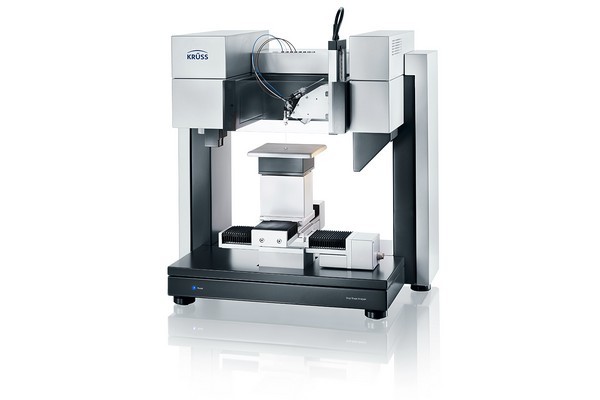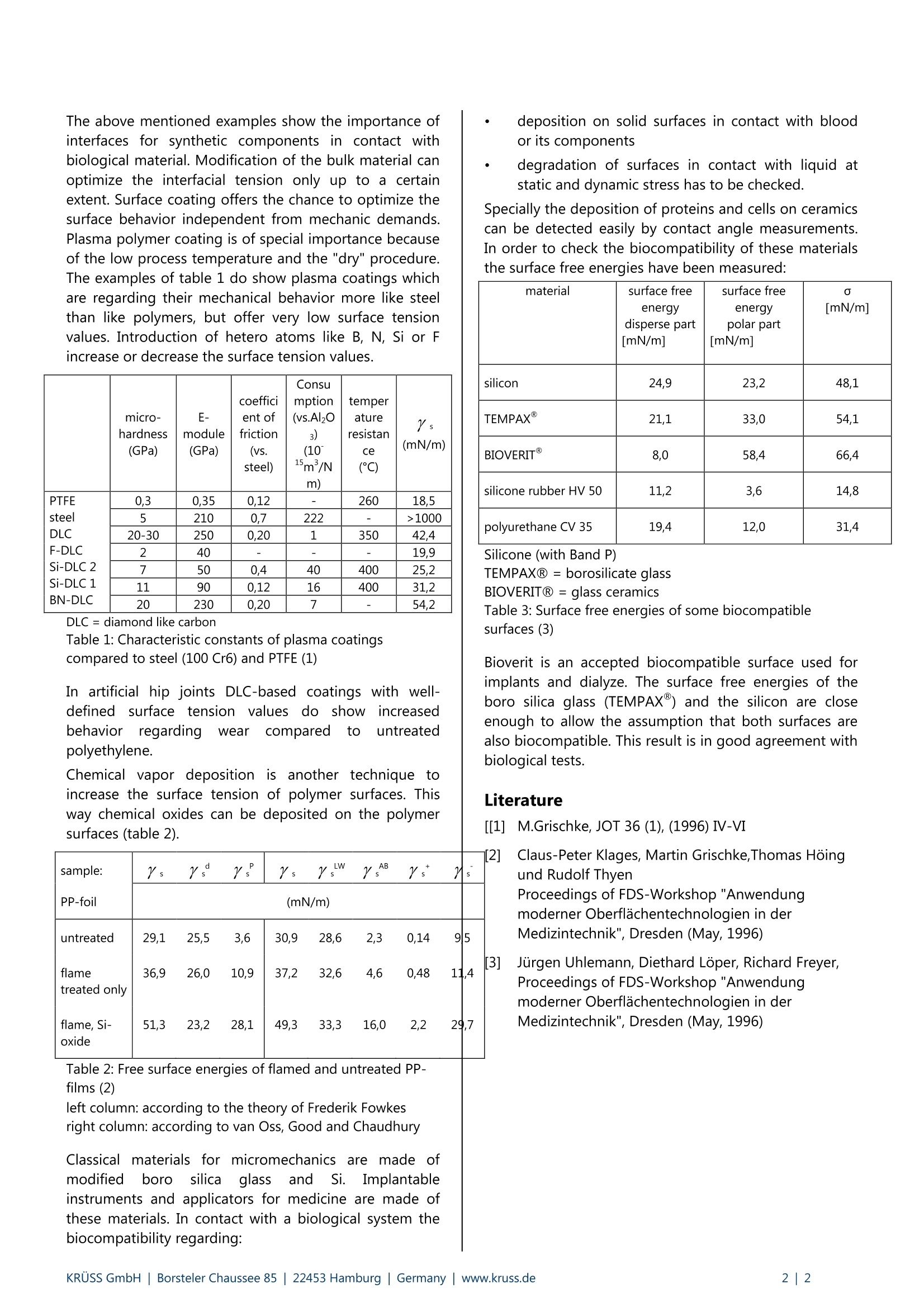
方案详情
文
寻找替代人体部位的人造技术是生物医学工程的一个重要课题。它可以是骨头、关节、牙齿、皮肤、头发、肌肉、血管、完整器官或药物传输系统。但人造材料的对机械强度以及化学和电子信息的传递要求很高。这取决于组成的生物相容性生物惰性等。本文以牙齿为例对其表面作出研究。
方案详情

Application Report Surface Characterization in Biomedical Engineering A major subject of biomedical engineering is the development of artificial, technically produced components for thereplacement of natural components in a human body. These components can be bones or parts of it, joints, teeth, implants for teeth, skin, hair, sinews, vessels, complete organsor drug delivery systems. High demands regarding mechanical stability and transfer of information by chemical and electrical processes are put onthese artificial materials. Depending on the function of each component it has to be either biocompatible, bio-tolerant orbio-inert. A simple, but illustrative example is a tooth implant. First of all the tooth has to be stable enough to transfer the forcesduring chewing from the surface to the bones. This is a mechanical problem. The surfaces should be non-wetting to avoidthe settlement of Bacteria. This is a surface tension problem. The middle part of a tooth should have a very goodbonding to the gums (biophil to tissue)) but alsobiophobe to Bacteria. Surface modification of artificial material in contact withbody fluids by corona-, plasma- or flame treatment canhelp to avoid deposition of proteins and enzymes onvarious materials. Albumine and Fibrinogen tend toadsorb on polyester filter material. Treating these filtersbyv plasmadeposition (plasma ofH yhdroxyethyl-methacrylate (HEMA)) reduces the adsorption drastically.This effect can be understood by the theory of van Oss,Good and Chaudhury: By increasing the basic characterof the surface (o°)) w\ater with relatively high acidcomponent (o9=25.5) can increasingly compete inadsorption with the proteins. The adsorption of proteinsdecreases. Another example is to increase the surface tension ofpolymer surfacess (PTFE, PFS)in ammonia plasma(result = 44-48 mN/m) to increase the deposition ofendothel cells. These endothel cells are part of thenatural surfaces of blood vessels. The result is a "haemo-compatible" surface, based on polymers. In order to avoid bacteria adhesion, the surface tensionof polymer surfaces has to be as high as possible. Waterand bacteria (e.g. staphylococcus epidermi) compete inthe adsorption process. The surface tension of water issignificantly higher than the surface tension of thebacteria. An increase in the SFT value of the solid surfacewill decrease the ability of bacteria adsorption. The above mentioned examples show the importance ofinterfaces for synthetic components in contact withbiological material. Modification of the bulk material canoptimize the interfacial tension only up to a certainextent. Surface coating offers the chance to optimize thesurface behavior independent from mechanic demands.Plasma polymer coating is of special importance becauseof the low process temperature and the "dry" procedure.The examples of table 1 do show plasma coatings whichare regarding their mechanical behavior more like steelthan like polymers, but offer very low surface tensionvalues. Introduction of hetero atoms like B, N, Si or Fincrease or decrease the surface tension values. micro-hardness(GPa) E- module(GPa) coefficient offriction(vs.steel) Consumption(vs.Al2O3)(1015m/Nm) temperatureresistance(℃) /s (mN/m) PTFE steelDLCF-DLCSi-DLC 2Si-DLC1 BN-DLC 0,3 0.35 0.12 - 260 18,5 5 210 0,7 222 - >1000 20-30 250 0,20 1 350 42,4 2 40 - - - 19,9 7 50 0,4 40 400 25.2 11 90 0.12 16 400 31,2 20 230 0,20 7 一 54,2 DLC= diamond like carbon Table 1:Characteristic constants of plasma coatingscompared to steel (100 Cr6) and PTFE (1) In artificial hip joints DLC-based coatings with well-defined surface tension values do show increasedbehavior regarding Wear comparedtto untreatedpolyethylene. Chemical vapor deposition is another technique toincrease the surface tension of polymer surfaces. Thisway chemical oxides can be deposited on the polymersurfaces (table 2). sample:PP-foil )s Ys 丫s ysIysw ys Ys 11s (mN/m) untreated flametreated only flame, Si-oxide 29,1 25,5 3,636,9 26,0 10,9 51,3 23,2 28,1 30,9 28,6 2,3 0,1437,2 32,6 4,6 0,48 49,3 33,3 16,0 2,2 9511,4 29,7 Table 2: Free surface energies of flamed and untreated PP-films (2) left column: according to the theory of Frederik Fowkesright column: according to van Oss, Good and Chaudhury Classicalnmaterials for micromechanics are made ofmodified borosilicaglassandSi..Implantableinstruments and applicators for medicine are made ofthese materials. In contact with a biological system thebiocompatibility regarding: deposition on solid surfaces in contact with bloodor its components degradation of surfaces in contact with liquid atstatic and dynamic stress has to be checked. Specially the deposition of proteins and cells on ceramicscan be detected easily by contact angle measurements.In order to check the biocompatibility of these materialsthe surface free energies have been measured: material surface freeenergy disperse part[mN/m] surface free energypolar part [mN/m] 0 [mN/m] silicon 24,9 23,2 48,1 TEMPAX 21,1 33,0 54,1 BIOVERIT 8,0 58,4 66,4 silicone rubber HV 50 11,2 3,6 14,8 polyurethane CV 35 19,4 12,0 31,4 Silicone (with Band P) TEMPAXQ= borosilicate glass BIOVERITQ = glass ceramics Table 3:Surface free energies of some biocompatible surfaces (3) Bioverit is an accepted biocompatible surface used forimplants and dialyze. The surface free energies of theboro silica glass (TEMPAX) and the silicon are closeenough to allow the assumption that both surfaces arealso biocompatible. This result is in good agreement withbiological tests. Literature [[1]M.Grischke, JOT 36 (1), (1996) IV-VI 2] Claus-Peter Klages, Martin Grischke,Thomas Hoingund Rudolf ThyenProceedings of FDS-Workshop "Anwendungmoderner Oberflachentechnologien in derMedizintechnik", Dresden (May, 1996) 3] Jurgen Uhlemann, Diethard Loper, Richard Freyer,Proceedings of FDS-Workshop "Anwendungmoderner Oberflachentechnologien in derMedizintechnik", Dresden (May, 1996) KRUSS GmbH| Borsteler Chaussee Hamburg| Germany|www.kruss.de|
确定


还剩1页未读,是否继续阅读?
克吕士科学仪器(上海)有限公司为您提供《牙齿中接触角检测方案(接触角测量仪)》,该方案主要用于牙齿中接触角检测,参考标准--,《牙齿中接触角检测方案(接触角测量仪)》用到的仪器有KRUSS DSA100接触角测量仪
相关方案
更多









